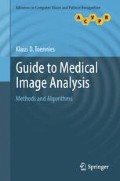Abstract
Selection of an image acquisition technique is intentional in medical imaging. It can be assumed that pixel or voxel values in a medical image cover more semantics with respect to object class membership than intensity in a photograph. Hence, image segmentation can be done as classification in feature space where image intensities are the features.
The dimensionality of feature space is usually low and the number of samples characterizing object classes is high. Typical classifiers discussed in this chapter take this into account and estimate likelihood functions from samples. Classification is then done by computing a posteriori probabilities for each object class.
Clustering in feature space will be discussed as well. Without requiring training, clustering may directly lead to a segmentation. Even if this is not the case, clustering may be used to reduce the workload for producing the training data.
Access this chapter
Tax calculation will be finalised at checkout
Purchases are for personal use only
Notes
- 1.
The a priori probability is also called marginal probability, since P is marginalized over all possible feature values of v.
References
Besag J (1986) On the statistical analysis of dirty pictures. J R Stat Soc B (Methodol) 48(3):259–302
Bouman CA, Shapiro M (1994) A multiscale random field model for Bayesian image segmentation. IEEE Trans Image Process 3(2):162–177
Boykov Y, Veksler O, Zabih R (2001) Fast approximate energy minimization via graph cuts. IEEE Trans Pattern Anal Mach Intell 23(11):1222–1239
Bradley PS, Fayyad UM (1998) Refining initial points for k-means clustering. In: Proc 15th intl conf machine learning, pp 91–99
Celeux G, Forbes F, Peyrard N (2003) Procedures using mean field-like approximations for Markov model-based image segmentation. Pattern Recognit 36(1):131–144
Cheng H, Bouman CA (2001) Multiscale Bayesian segmentation using a trainable context model. IEEE Trans Image Process 10(4):511–525
Comaniciu D, Meer P (2002) Mean shift: a robust approach toward feature space analysis. IEEE Trans Pattern Anal Mach Intell 24(5):603–619
Duda RO, Hart PE, Stork DG (2000) Pattern classification: pattern classification. Pt 1, 2nd edn. Wiley, New York
Fukunagu K, Hostetler LD (1975) The estimation of the gradient of a density function with applications in pattern recognition. IEEE Trans Inf Theory 21:32–40
Geman S, Geman D (1984) Stochastic relaxation, Gibbs distributions, and the Bayesian restoration of images. IEEE Trans Pattern Anal Mach Intell 6(6):721–741
Held K, Kops ER, Krause BJ, Wells WW III, Kikinis R, Muller-Gartner HW (1997) Markov random field segmentation of brain MR images. IEEE Trans Med Imaging 16(6):878–886
Jiang Y, Chen KJ, Zhou ZH (2003) SOM based image segmentation. In: Lecture notes in computer science. LNCS, vol 2639, pp 640–643
Kaufman L, Rousseeuw PJ (2005) Finding groups in data: an introduction to cluster analysis. Wiley, New York
Kohonen T (1995) Self-organizing maps. Springer, Berlin
McLachlan GJ, Krishnan T (1996) The EM algorithm and extensions. Wiley-Interscience, New York
Marroquin JL, Santana EA, Botello S (2003) Hidden Markov measure field models for image segmentation. IEEE Trans Pattern Anal Mach Intell 25(11):1380–1387
Ng HP, Ong SH, Foong KWC, Goh PS, Nowinski WL (2006) Medical image segmentation using k-means clustering and improved watershed algorithm. In: IEEE Southwest Symposium on Image Analysis and Interpretation, pp 61–65
Peña JM, Lozano JA, Larrañaga P (1999) An empirical comparison of four initialization methods for the k-means algorithm. Pattern Recognit Lett 20(10):1027–1040
Reddick WE, Glass JO, Cook EN, Elkin TD, Deaton RJ (1997) Automated segmentation and classification of multispectral magnetic resonance images of brain using artificial neural networks. IEEE Trans Med Imaging 16(6):911–918
Shapira L, Avidan S, Shamir A (2009) Mode-detection via median-shift. In: Intl conf computer vision (ICCV), pp 1909–1916
Tuzel O, Porikli F, Meer P (2008) Pedestrian detection via classification on Riemannian manifolds. IEEE Trans Pattern Anal Mach Intell 30(10):1713–1727
Tuzel O, Porikli F, Meer P (2009) Kernel methods for weakly supervised mean shift clustering. In: Intl conf computer vision (ICCV 2009), pp 59–68
Zhang J (1992) The mean field theory in EM procedures for Markov random fields. IEEE Trans Signal Process 40(10):2570–2583
Author information
Authors and Affiliations
Rights and permissions
Copyright information
© 2012 Springer-Verlag London Limited
About this chapter
Cite this chapter
Toennies, K.D. (2012). Segmentation in Feature Space. In: Guide to Medical Image Analysis. Advances in Computer Vision and Pattern Recognition. Springer, London. https://doi.org/10.1007/978-1-4471-2751-2_7
Download citation
DOI: https://doi.org/10.1007/978-1-4471-2751-2_7
Publisher Name: Springer, London
Print ISBN: 978-1-4471-2750-5
Online ISBN: 978-1-4471-2751-2
eBook Packages: Computer ScienceComputer Science (R0)

